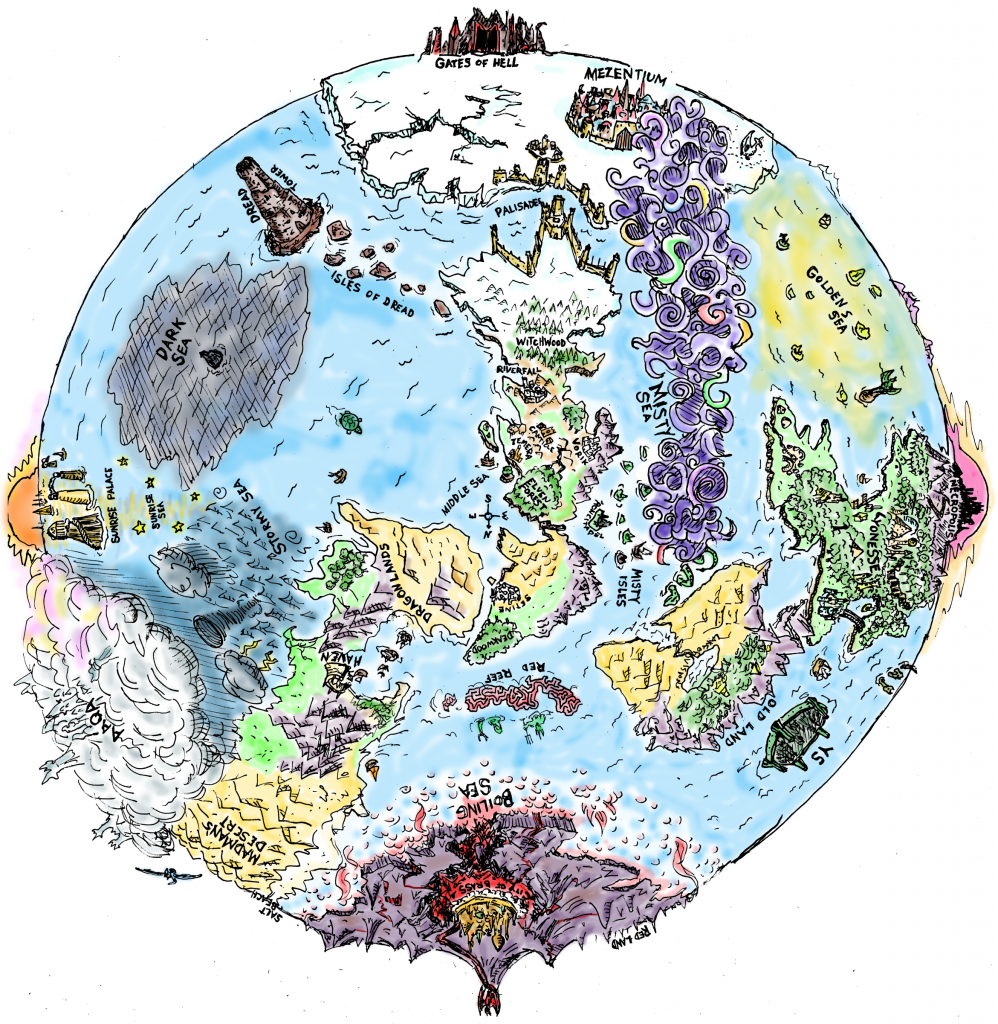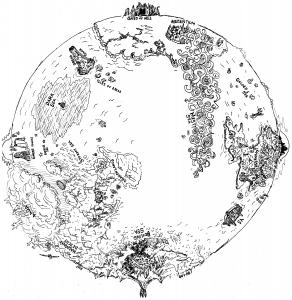When I first saw the Walsperger Map, a medieval German world map, I was struck by the fact that the Kingdom of Heaven is a physical place at the edge of the map (located vaguely in the China area). You could walk to Heaven! I thought it would be fun to make a D&D world map based on this conceit. All the planes of the Great Wheel are accessible by walking to different corners of the world.
Here’s the map I drew based on this idea.
My actual campaign map is the little continent in the middle: radiating outwards, the locations become more outlandish until, at the edges of the world, you find the City of Brass, the Gates of Hell, and other magical locations. Each of these is a gateway to a plane. You might sail into the city of Ys from the Prime Material Plane, and sail out again into the Plane of Water.
I’ve narrowed down the many Great Wheel locations to ten big portals.
The Outer Planes: I’ve lumped all the realms of the gods together in the east, in a series of islands in the Sunrise Sea. Presumably, Celestia and Bytopia and all the other outer planes are each represented by an island: once you set foot on one, you might find yourself on the infinite plane described in the various Manuals of the Planes. Or maybe they’re just big islands. That’s up to the DM.
Similarly, I lump the Abyss, Hades, Gehenna, etc. into “the hells”. All the demons and devils have to share that mailing address. Since the Gates of Hell have a physical location (the frozen South), every general who claims that his men would follow him “to the gates of Hell” has a chance to try and prove it.
The Inner Planes: I’ve spent some time thinking about the elemental planes and how I could make them into adventure locations.
I decided that the plane of air is the ever-changing world above us, of cloud castles and cloud giants. Normally, the clouds are insubstantial to you, unless you first travel to the canonical D&D location of Aaqa.
The Plane of Fire can be entered by another canonical D&D place: the City of Brass, which I put at the pole of the Burning North. (If you prefer your north frozen and your south burning, you can use my map upside down: all you have to do is reverse the compass rose and rename the Sunrise Sea to the Sunset Sea).
I think that, in a game where the ground is riddled with dungeons, the Plane of Earth is the most sinister of the inner planes. In my cosmology, it’s a plane of infinite Gygaxian dungeons: the Mythic Underworld. Somewhat perversely, I placed its entrance in a mountain-sized tower on an island. But hey, sometimes dungeons are in mountains.
Finally, if you want to get to the swashbuckling, nautical Plane of Water, you can go through the real-world-myth city of Ys, which is built below high-tide sea level and only protected from inundation by its high bronze walls and gates.
The Fourth Edition Planes: 4e brought the Feywild and the Shadowfell into the D&D cosmology, and I think they deserve a place on the Great Wheel. I’ve put them both in the West.
The land where the sun sets is a good place for the palace of Death. I picture the Necropolis as a completely empty and still city. If you hear the sounds of a carriage or a horse from a neighboring street, don’t seek it out: it’s Death on his way to work. If you enter the city’s palace, you might find Death, alone and bored, lounging on his throne, and willing to play a game with you, for the right stakes.
Fairyland is also to the west. I’ve called my fairyland Lyonesse, after an Earth myth of a lost Western land and after Jack Vance’s fantasy series. The Lyonesse and Ys myths are related, and, on my map, they’re next to each other. An elvish land belongs in the west of the world. Tolkien’s elves were a people in decline, and going West was their equivalent to dying. I’ve made Lyonesse a resting point on the way to the land of death.
Other Material Planes: My campaign world also uses a conceit from the 3rd Edition Manual of the Planes. In the “Winding Road” cosmology, every Prime Material Plane is connected to exactly two other Prime Material planes along an infinite road. (I didn’t even know about this cosmology until I read James Wyatt’s recent article. I thought I invented it!) I’ve created gates that link my world to two Prime Material planes: 1) a desert that only a madman can cross (a feature borrowed from Rory’s game map); and 2) a high-magical-technology city called Mezentium that recently appeared out of the southern mists, threatening the Southern lands.
I filled my map with heightened-magical-reality obstacles to easy planar travel: the Boiling Sea, the Islands of Dread, the Dark Sea, the Mists, the Dragonlands, and the Sea of Storms guard the portals. There should be no mundane merchant caravans to the realms of the gods or the City of Brass. Only mid- or high-level heroes can get there, and only after larger-than-life journeys.
My map is inspired by medieval European maps, which were pieced together from traveler’s tales and guesswork. Therefore, in-game, my map is just as untrustworthy, and just as speculative around the edges. Maybe Lyonesse is twice as big, or maybe the Golden Sea doesn’t exist at all. It all depends on what I, as a DM, need for my next adventure.
Here’s a copy of my map with the center left blank for your own continent:










Brilliant. I love the idea of being able to physically go to the other planes. And i love your execution of that idea.
Brilliant.
Yes! Make it into a color poster we can buy! =)
Fantastic. In all the usual senses of the word.
This makes me think of the land of Oz. Canonically, Oz isn’t a parallel world like Narnia that can only be reached by magic, but simply a distant place. It’s just hard to get to because it’s surrounded by one of your magical obstacles: the Deadly Desert, which turns people to sand if they touch it. This is why Oz is generally reached by air.
This is all kinds of awesome. I’ve never thought of having all the planes connected directly to the physical plane. I’ve always followed the Norse sort of cosmology with all the planes being connected to the roots and limbs of Yggdrasil, and the prime material planes held around the tree’s center by the mythical plane/city of Atlantis. I might have to look into putting your map to work in my game though. I believe it would make for a very interesting series of adventures.
It also reminds me of Stephen Kings Dark Tower Cycle, and how Roland and his Ka-tet travelled from world to world by moving up and down the tower’s levels.
I’ve never read Stephen King’s Dark Tower, but both it and my “Dread Tower” were inspired by the Browning poem
Yes, baf, it’s totally Oz! That’s one of the most wonderful things about Oz–you can just end up there due to adverse weather conditions/rogue hot air balloons, without any magical powers at all! and of course in the movie Oz isn’t really even magical, right? It’s all self-confidence or whatever. The Secret!
Well, White Wolf’s Exalted basically HANGS upon the idea of the magical places/realms as actual physical locations one might reach in the borders of the creation if bold and resourceful enough.
Not to mention the endless varied strangeness of the Chaos beyond those borders or the Endless Desert – that is an imprisoned fallen titan – that leads to the Demon World of Malfeas, defeated titan-king turned hell-realm by its usurpers, divine & mortal.
Worth checking out i think but as a fan i might be a bit biased. 😛
Wow! I’ve never read or played Exalted but that sounds boss!
That looks like the coolest D&D world in the history of ever.